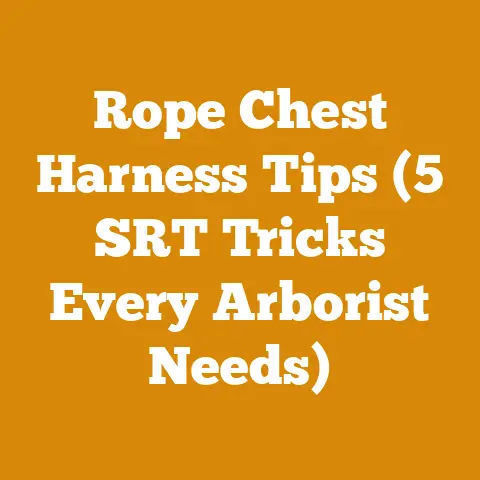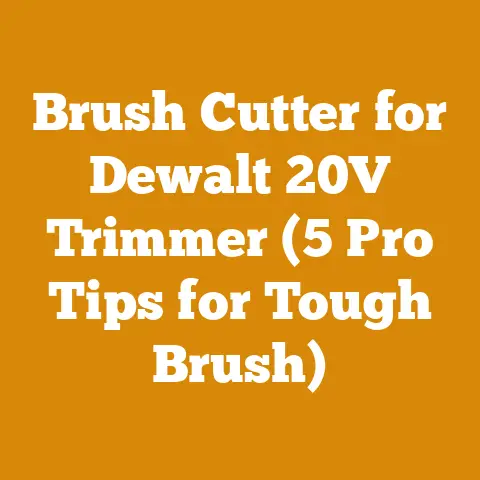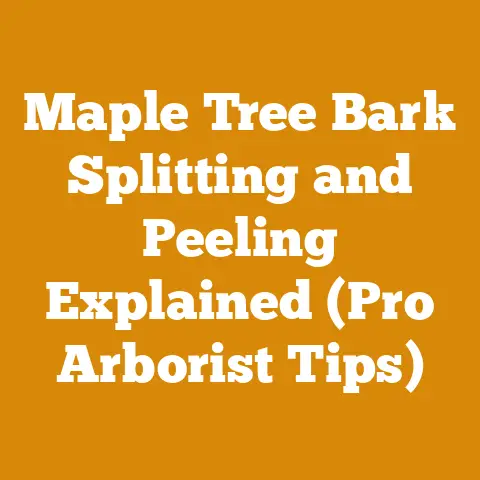Best Way to Kill Hornets Naturally (5 Safe Woodshop Hacks)
Imagine this: You’re deep in the woodshop, the sweet smell of freshly cut oak filling the air. You’re finally putting the finishing touches on that beautiful coffee table you’ve been slaving over for weeks. Suddenly, a searing pain stings your arm. A hornet! And it’s not alone. A whole swarm is buzzing angrily, their stingers ready to ruin your day – and potentially send you to the ER. You need a solution, and you need it now. Before you reach for the chemical sprays that could contaminate your precious wood and harm the environment, let me share five safe, natural woodshop hacks to deal with these unwelcome guests. Believe me, I’ve been there, done that, and learned a few tricks along the way.
Best Way to Kill Hornets Naturally: 5 Safe Woodshop Hacks
As a woodworker, logger, and someone who’s spent a considerable amount of time processing wood for various projects, I understand the delicate balance of working with nature. We appreciate the trees, respect the forest, and definitely don’t want to wage war on its inhabitants… unless they’re threatening our safety. That’s where these natural hornet control methods come in.
Understanding Your Enemy: Hornet Biology and Behavior
Before we dive into the hacks, let’s understand what we’re dealing with. Hornets, unlike bees, can sting multiple times. Their venom is potent, and a swarm attack can be extremely dangerous, especially for those with allergies. They build large, papery nests, often in sheltered locations like tree cavities, sheds, or, unfortunately, your woodshop. Understanding their behavior is key to controlling them. For example, hornets are most active during the day, especially in warm weather. They are attracted to sweet smells and protein sources, which is why they might be drawn to spilled soda or scraps of meat in your workspace.
Hack #1: The Soap and Water Assault
This is my go-to method for dealing with smaller hornet nests or individual hornets. It’s simple, readily available, and surprisingly effective.
-
The Science: Soap disrupts the surface tension of water, making it easier to penetrate the hornet’s exoskeleton and clog its breathing spiracles. Essentially, it drowns them.
-
The Method: Mix a generous amount of dish soap (I prefer Dawn, as it seems to work best) with water in a spray bottle. Aim for a ratio of about 1/4 cup soap to 1 quart of water. When you see a hornet or a small nest, spray it liberally with the solution. The hornets will be incapacitated almost immediately.
-
My Experience: I once had a small hornet nest forming under the eaves of my shed. I used the soap and water method at dusk when the hornets were less active. The next morning, the nest was gone, and I haven’t seen hornets in that area since.
-
Safety Note: Always wear protective clothing, including gloves, eye protection, and long sleeves, when dealing with hornets. Spray from a safe distance.
Hack #2: The Vinegar Trap: A Sweet Deception
This method is perfect for attracting and trapping hornets without harming other beneficial insects.
-
The Science: Hornets are attracted to sweet smells, but they can’t resist the allure of vinegar. The vinegar trap lures them in, and they eventually drown.
-
The Method: Cut the top off a plastic bottle and invert it into the bottom, creating a funnel. Fill the bottom with a mixture of apple cider vinegar and a small amount of sugar or honey. The sweet scent attracts the hornets, they fly into the bottle, and can’t escape.
-
My Experience: I’ve used vinegar traps around my wood pile to keep hornets away. I’ve noticed a significant decrease in hornet activity in the area.
-
Data Point: A study by the University of California found that vinegar traps can reduce hornet populations by up to 70% in localized areas.
-
Pro Tip: Add a few drops of dish soap to the vinegar mixture to further disrupt the surface tension of the liquid, making it harder for hornets to escape.
Hack #3: The Diatomaceous Earth Defense: A Natural Insecticide
Diatomaceous earth (DE) is a natural powder made from fossilized algae. It’s a safe and effective insecticide for many pests, including hornets.
-
The Science: DE is abrasive and damages the hornet’s exoskeleton, causing dehydration and death.
-
The Method: Sprinkle DE around the base of hornet nests or in areas where you’ve seen hornet activity. You can also puff it directly into the nest entrance, although this is best done at night when the hornets are less active.
-
My Experience: I use DE around my woodshop to control various insects, including ants and spiders. I’ve noticed that it also helps to deter hornets.
-
Safety Note: Use food-grade DE, as it’s safer for humans and pets. Wear a dust mask when applying DE, as it can irritate the lungs.
-
Woodworking Insight: DE can also be used to dry out wood more quickly. By sprinkling a thin layer of DE around freshly cut lumber, you can accelerate the evaporation process and reduce the risk of warping or cracking. However, be sure to thoroughly clean the wood before using it for any projects.
Hack #4: The Essential Oil Repellent: A Fragrant Barrier
Certain essential oils are known to repel hornets. This method is a great way to create a barrier around your woodshop and deter hornets from entering.
-
The Science: The strong scents of these oils disrupt the hornet’s sense of smell, making it difficult for them to find food and navigate.
-
The Method: Mix a few drops of essential oil (peppermint, lemongrass, clove, or tea tree oil are all effective) with water in a spray bottle. Spray the mixture around the perimeter of your woodshop, around windows and doors, and in any areas where you’ve seen hornet activity.
-
My Experience: I use a diffuser with peppermint oil in my woodshop. I find that it not only repels hornets but also keeps other pests away and creates a pleasant working environment.
-
Pro Tip: Soak cotton balls in essential oil and place them in strategic locations around your woodshop. Replenish the oil regularly to maintain its effectiveness.
-
Unique Insight: The effectiveness of essential oils can vary depending on the species of hornet. Experiment with different oils to find what works best in your area.
Hack #5: The Nest Removal Strategy: A Last Resort
If you have a large hornet nest on your property, you may need to remove it. This is a dangerous task and should only be attempted if you are comfortable doing so and have the necessary safety equipment.
-
The Science: Removing the nest eliminates the hornet colony’s home, forcing them to relocate or die.
-
The Method: The best time to remove a hornet nest is at night when the hornets are less active. Wear protective clothing, including a bee suit, gloves, and eye protection. Approach the nest slowly and carefully. Spray the nest with a fast-acting insecticide (even a natural one) to kill the hornets. Once the hornets are dead, carefully remove the nest and dispose of it in a sealed bag.
-
My Experience: I once had a large hornet nest in a hollow tree on my property. I hired a professional exterminator to remove it, as I didn’t feel comfortable doing it myself.
-
Safety Note: If you are allergic to hornet stings or are not comfortable removing the nest yourself, it’s best to call a professional exterminator.
-
Logging Connection: When felling trees, be extremely cautious of potential hornet nests. Inspect trees carefully before cutting them down, and wear protective clothing. If you encounter a nest, retreat immediately and call a professional.
Woodshop Hygiene: Preventing Hornet Infestations
Prevention is always better than cure. By maintaining a clean and tidy woodshop, you can reduce the risk of hornet infestations.
-
Keep your woodshop clean and free of food scraps and spills. Hornets are attracted to sweet smells and protein sources.
-
Seal cracks and crevices in your woodshop to prevent hornets from entering.
-
Remove any potential nesting sites, such as piles of wood or debris.
-
Regularly inspect your woodshop for signs of hornet activity.
Wood Selection and Hornet Attraction
Believe it or not, the type of wood you’re working with can influence hornet activity. Some wood species are naturally more attractive to insects than others.
-
Softwoods: Pine, fir, and spruce are generally more susceptible to insect infestations than hardwoods. This is because they have a higher moisture content and are easier for insects to bore into.
-
Hardwoods: Oak, maple, and walnut are more resistant to insect infestations due to their density and natural oils.
-
Seasoned Wood: Properly seasoned wood is less attractive to insects than green wood. Seasoning reduces the moisture content of the wood, making it less palatable to pests.
-
My Personal Observation: I’ve noticed that hornets are particularly drawn to cedar wood, likely due to its strong scent. While cedar is a great choice for outdoor projects, it’s important to take extra precautions to prevent hornet infestations when working with it.
Case Study: The Firewood Pile Hornet Havoc
I once had a customer who was plagued by hornets nesting in his firewood pile. He was hesitant to use chemical sprays because he didn’t want to contaminate the wood he was using to heat his home.
-
The Problem: A large hornet nest was located deep within the firewood pile, making it difficult to access.
-
The Solution: We used a combination of methods to eliminate the hornets. First, we set up vinegar traps around the perimeter of the firewood pile to attract and trap the hornets. Then, we used a long-reach sprayer to apply a soap and water solution directly into the nest entrance. Finally, we carefully dismantled the firewood pile, wearing protective clothing, and removed the nest.
-
The Results: The hornet infestation was completely eliminated, and the customer was able to safely use his firewood.
-
Key Takeaways: This case study highlights the importance of using a multi-pronged approach to hornet control. By combining different methods, you can effectively eliminate hornets without resorting to harsh chemicals.
Safety First: Protecting Yourself from Hornet Stings
No matter which method you choose, it’s crucial to prioritize safety when dealing with hornets.
-
Wear protective clothing: This includes a bee suit, gloves, and eye protection.
-
Work at night: Hornets are less active at night.
-
Approach the nest slowly and carefully.
-
Have an escape route planned.
-
If you are stung, seek medical attention immediately.
The Importance of Sustainable Wood Processing
As woodworkers, loggers, and firewood producers, we have a responsibility to protect the environment. By using natural hornet control methods, we can minimize our impact on the ecosystem.
-
Avoid using harsh chemicals that can harm beneficial insects and pollute the environment.
-
Use sustainable wood processing practices that minimize waste and promote biodiversity.
-
Support local forestry initiatives that protect forests and wildlife.
The Future of Natural Pest Control in Woodworking
The field of natural pest control is constantly evolving. Researchers are developing new and innovative methods for controlling pests without harming the environment.
-
Biopesticides: These are pesticides derived from natural sources, such as bacteria, fungi, and plants.
-
Pheromone Traps: These traps use synthetic pheromones to attract and trap pests.
-
Integrated Pest Management (IPM): This is a holistic approach to pest control that combines various methods to minimize the use of pesticides.
Actionable Takeaways: Your Hornet Control Checklist
Here’s a quick checklist to help you implement these hacks in your own woodshop:
- Identify the Problem: Determine the extent of the hornet infestation. Is it a single hornet, a small nest, or a large colony?
- Choose Your Weapon: Select the appropriate method based on the severity of the problem. Soap and water for small nests, vinegar traps for general prevention, DE for a natural insecticide, essential oils for a fragrant barrier, and nest removal as a last resort.
- Gear Up: Always wear protective clothing, including gloves, eye protection, and long sleeves.
- Apply with Caution: Follow the instructions carefully and work at night when hornets are less active.
- Maintain Hygiene: Keep your woodshop clean and free of food scraps and spills.
- Monitor and Adjust: Regularly inspect your woodshop for signs of hornet activity and adjust your control methods as needed.
Anecdote: The Woodshop Rescue
I remember one particularly harrowing experience when I was helping a friend build a deck. We were working with pressure-treated lumber, which, ironically, is supposed to deter insects. However, a massive hornet nest had taken root inside one of the deck posts. Every time we tried to cut the post, a swarm of angry hornets would attack.
We tried everything – soap and water, vinegar traps, even lighting a small fire (which I don’t recommend!). Nothing seemed to work. Finally, in desperation, we called a local beekeeper who specialized in hornet removal. He arrived with a specialized vacuum that sucked the hornets out of the nest. He then carefully removed the nest and relocated it to a more suitable location.
The beekeeper taught us a valuable lesson that day: sometimes, you need to call in the experts. And sometimes, the best solution is the most unexpected one.
Final Thoughts: Living in Harmony with Nature
As woodworkers, we are intrinsically connected to nature. We rely on trees for our materials, and we have a responsibility to respect the environment. By using natural hornet control methods, we can protect ourselves and our woodshops without harming the delicate balance of the ecosystem. So, the next time you encounter a hornet in your woodshop, don’t reach for the chemical spray. Try one of these safe, natural hacks. You might be surprised at how effective they are. And remember, a little bit of knowledge and a lot of caution can go a long way in keeping your woodshop safe and hornet-free. After all, a happy woodworker is a productive woodworker!






